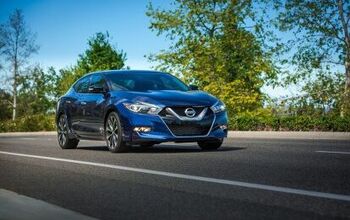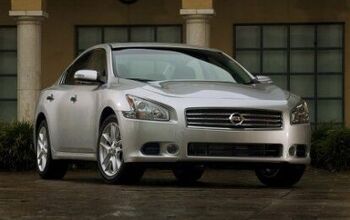New Life for the Shrinking Nissan Maxima?

Nissan’s future will not see it become everything to everyone, and certainly not in all markets. The 2010s, and the market share-chasing, globe-straddling expansionism that characterized that decade’s car-buying orgy, are violently over.
Also soon to be over, apparently, is the Nissan Maxima’s gasoline-powered powertrain.
The large-ish Nissan sedan’s fate has been the subject of much speculation ever since the current-generation model appeared. With a standard CVT and sports-sedan marketing pitch in tow, the Maxima didn’t wow reviewers, leaving many wondering exactly what its purpose is.
And as Nissan’s fortunes fell along with the Maxima’s sales, some pointed to a new role for the passenger car range-topper. That speculation gained new heat in early 2019, after Nissan revealed its electric IMs sports sedan concept. Boasting power aplenty (dual motors, 483 horsepower and 590 lb-ft of torque, and a claimed driving range of 380 miles), the concept hinted at a change at the top of Nissan’s car lineup.
Following Nissan’s sales and cash crunch, coupled with the secondary economic bite of the pandemic, Automotive News feels confident in claiming that the next-generation Maxima “should” appear in the form of the IMs. Whether or not the name Maxima is retained remains to be seen.
The same can be said for the appearance of customers. If people didn’t show up for the Maxima, would a ballsier sedan that ditches internal combustion make a difference? Can any non-premium passenger car, even if electric, rake it in? Tesla seems to prove that, yes, such vehicles can, though sales of the Model 3 and its brethren are juiced by Silicon Valley tech devotion and the futurist aura surrounding the company’s CEO.
If Nissan does replace the Maxima, it should appear in the second half of 2022.
The Maxima found 35,076 U.S. buyers in 2019, almost half of the volume the model enjoyed just two years prior. The bump in interest seen after the current generation’s debut quickly tapered off. Between 1994 and 2001, the Maxima reliably sold well over 100,000 units per year in the United States, with similar showings in 1986, 1989, and 1990.
[Image: Nissan]

More by Steph Willems
Latest Car Reviews
Read moreLatest Product Reviews
Read moreRecent Comments
- Brendan Duddy soon we'll see lawyers advertising big payout$ after getting injured by a 'rogue' vehicle
- Zerofoo @VoGhost - The earth is in a 12,000 year long warming cycle. Before that most of North America was covered by a glacier 2 miles thick in some places. Where did that glacier go? Industrial CO2 emissions didn't cause the melt. Climate change frauds have done a masterful job correlating .04% of our atmosphere with a 12,000 year warming trend and then blaming human industrial activity for something that long predates those human activities. Human caused climate change is a lie.
- Probert They already have hybrids, but these won't ever be them as they are built on the modular E-GMP skateboard.
- Justin You guys still looking for that sportbak? I just saw one on the Facebook marketplace in Arizona
- 28-Cars-Later I cannot remember what happens now, but there are whiteblocks in this period which develop a "tick" like sound which indicates they are toast (maybe head gasket?). Ten or so years ago I looked at an '03 or '04 S60 (I forget why) and I brought my Volvo indy along to tell me if it was worth my time - it ticked and that's when I learned this. This XC90 is probably worth about $300 as it sits, not kidding, and it will cost you conservatively $2500 for an engine swap (all the ones I see on car-part.com have north of 130K miles starting at $1,100 and that's not including freight to a shop, shop labor, other internals to do such as timing belt while engine out etc).


































Comments
Join the conversation
I will never forget how one day I discovered that the cruise control on my 2003 Maxima SE with manual transmission would NOT remain set at 93 mph, but was perfectly happy at 92. Obviously, the Japanese engineer (or regulator) felt 150 kph was fast enough on cruise.
I think the Maxima exists soley as an upsell to an Altima intender whose money or credit extended upwards...probably costs the same to produce. Every CVT I've driven detracted from the car and engine. It may have uses, sport isn't one. Toss me a real tranny, willya ? Companies hate the transmission in general. Expensive to make, a lot of parts (less in a CVT), and you can't really charge more for them with options.